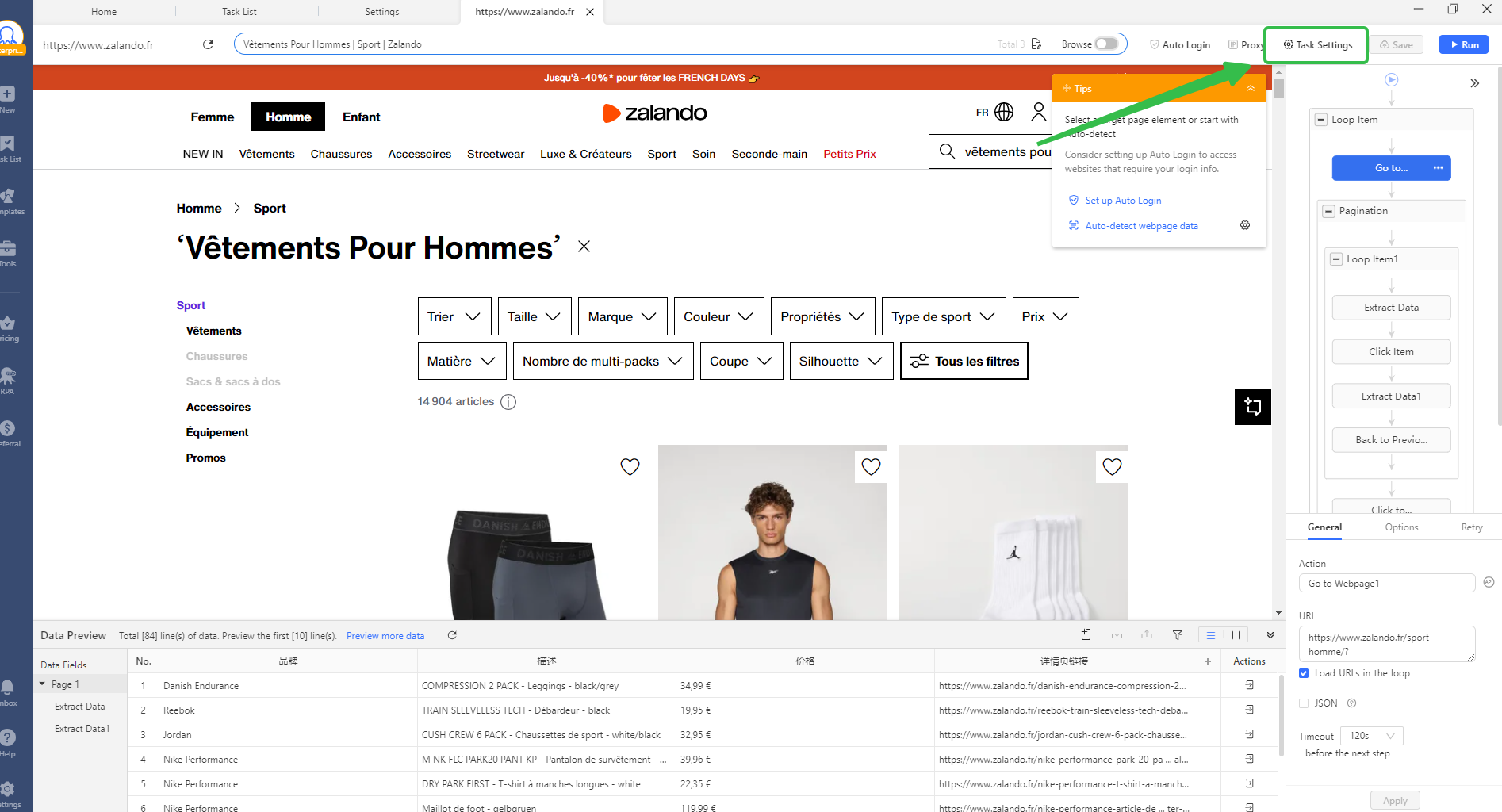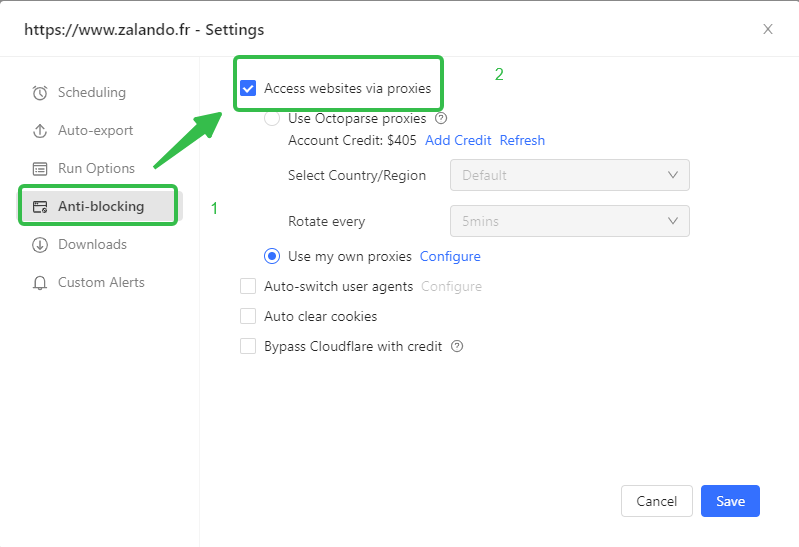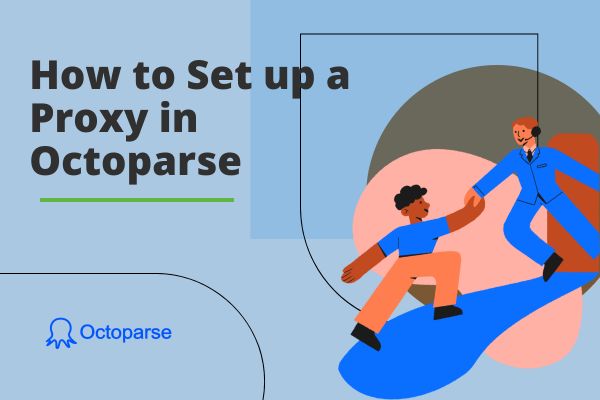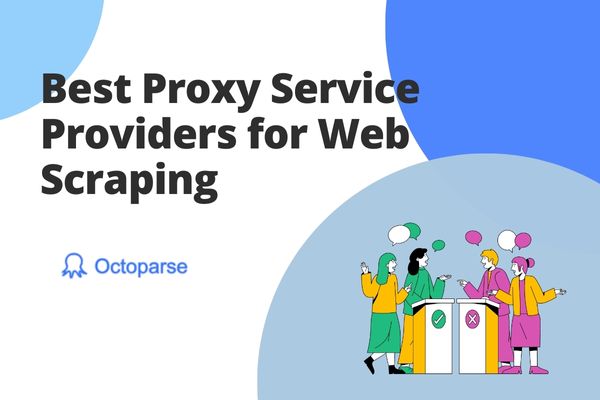When I first started scraping for market research, I kept running into blocks and endless CAPTCHAs. The reason was simple. Datacenter proxies seemed like a quick, affordable fix, but they didn’t hold up for long.
Then I discovered residential proxies – and they completely changed how I approach data collection.
If you’re dealing with blocked requests, need to scrape geo-restricted content, or want to run large-scale data operations without detection, this guide will walk you through everything you need to know about residential proxies: what residential proxies are, the different types, common use cases, how to choose the best residential proxy providers, and how to set them up in Octoparse. Here we go.
What is a Residential Proxy
Just as its name implies, a residential proxy is an intermediary server that uses IP addresses assigned by Internet Service Providers (ISPs) to real households and physical devices.
It is nothing like datacenter proxies that come from server farms, residential proxies send your internet traffic through real home connections, making it look like your requests are coming from everyday users.
To put it simply, when you connect via a residential proxy, you’re borrowing someone else’s home internet connection. The website you’re trying to access sees the request as coming from a valid residential IP address— the same kind of connection that millions of regular internet users rely on.
As a result, residential proxies are extremely useful for tasks that need a high level of anonymity and low chances of detection, like web scraping, ad verification, and market research. But here comes another question: how do residential proxies actually work behind the scenes?
How Residential Proxies Work
The process is pretty simple (but don’t underestimate it too soon):
- You send a request from your device or web scraper
- The proxy server intercepts it and hides your real IP
- The traffic then routes through a residential IP address from someone’s home network
- The website sees the request as coming from a genuine household
- The response travels back through the same proxy path to your device
What makes this setup effective is that residential proxies are deployed in real home networks—not in data centers. Because of that, they can make your traffic look a lot more like regular user behavior, which makes blocking or flagging you much harder.
What are the Benefits of Residential Proxies
Residential proxies are spread across tens of thousands of cities and ISPs, which helps them masquerade traffic as authentic residential user traffic. Such a working mechanism offers plenty of extra benefits according to studies and reports:
- Geo-targeted flexibility: Since IPs are spread across many locations and ISPs, you can appear to be browsing from almost anywhere. Useful for testing localized user experiences, ad placements, or simply accessing content restricted to certain regions.
- Higher success/scraping rates: Because the traffic looks “organic,” web requests are less likely to be flagged. Residential proxies outperform datacenter proxies in terms of consistency when scraping protected or sensitive sites.
- Reduced risk of blacklisting: Residential IPs are less likely to be on blocklists or get banned, since they mimic normal user behavior and come from trusted ISPs. This provides more stable long-term usage.
- Improved privacy/anonymity: It’s harder for websites or anti-bot systems to recognize scraping or automation activities, as the IPs are tied to real homes and mix in with regular user traffic.
If it’s hard to understand, no worries. The concept of a residential IP address will answer your questions.
What is a Residential IP Address
A residential IP address is basically a label your internet provider gives to your devices at home, like your phone, laptop, or smart TV. These IPs are linked to real addresses and actual users, which is why they’re seen as more trustworthy.
Key characteristics of residential IPs:
- Given out by legit ISPs (like Comcast, Verizon, AT&T, etc.)
- Tied to real physical addresses
- Change from time to time based on ISP rules
- Show up in ranges that websites recognize as legitimate
Datacenter IPs vs. Residential IPs:
- Datacenter IPs: Found in cloud servers, easy to spot by their IP ranges, faster but more detectable
- Residential IPs: Spread out across home networks, look just like regular users, slower but super trusted
This distinction is crucial because websites rely heavily on the trustfactor.
Residential proxies enable websites to trace IP addresses back to real locations and genuine users. This makes the activity look just like everyday browsing. So proxy traffic is less likely to be flagged or blocked.
In contrast, datacenter IPs often raise red flags since they originate from known server farms.
What are the Common Types of Residential Proxies
I know some of you are wondering how to choose the right solution for specific needs. Before making a decision, let me show you the common types of residential proxies:
Quick look at common types of residential proxies:
| Type | Pros | Cons | Common Use Cases |
| Mobile Residential Proxies | – Rarely blocked, high trust score – Natural IP rotation via cell towers – Great for mobile-first platforms – Can bypass carrier-grade NAT | – Very expensive (3–5x residential) – Slower connections – Limited session persistence – Battery/data constraints if using real devices | – Automating social media – Mobile app testing – Sneaker bots – Ad verification on mobile – Location-based service testing |
| Static Residential (ISP) Proxies | – Same IP for weeks/months – Datacenter-level speed – Stable uptime (99.9%) – Lower detection vs datacenter IPs | – Fewer locations – High cost per IP – Smaller pool – Availability depends on ISP partnerships | – Long-term account management – Competitor/brand monitoring – Customer service automation – High-value data collection – SaaS applications |
| Rotating Residential Proxies | – Huge pools (millions of IPs) – Automatic rotation per request/session – Global coverage (150+ countries) – Scalable for large jobs – Cost-effective at high volumes | – Hard to maintain logins/sessions – More complex setup – Inconsistent speeds – IP quality can vary | – Large-scale scraping – SERP tracking – Price monitoring – Ad verification – Market research – Travel/real estate data |
| Dedicated Residential Proxies | – Exclusive IPs, no sharing – Reliable performance – Customizable rotation – Priority support – Good for compliance | – Premium cost (2–4x shared) – Smaller IP pool – Usually monthly contracts – Less flexible for scaling | – Enterprise-grade data collection – Automated trading/finance – Healthcare/pharma data – Legal research – Business intelligence |
| Shared Residential Proxies | – Most affordable option – Diverse IP pool – Easy to scale – Flexible pay-as-you-go – Great for testing | – Risk of shared IP conflicts – Performance can fluctuate – Less control/customization – Possible IP contamination – Fair use limits | – General scraping – Market research – Ad verification – SEO & SERP analysis – SMB automation – Academic research |
1. Mobile Residential Proxies
Mobile residential proxies utilize IP addresses that are assigned to smartphones and tablets by cellular providers such as Verizon, AT&T, or T-Mobile. These IPs are considered highly trustworthy because they emulate real mobile users who often switch locations and network towers.
😊Pros:
- Outstanding trust scores: mobile IPs are rarely blocked by websites.
- Natural IP rotation: carriers seamlessly rotate IPs as users switch between cell towers.
- Perfect for mobile-first platforms: great for apps like Instagram, TikTok, and others.
- Bypass carrier-grade NAT detection: multiple users can share the same IP without issues arising.
😔Cons:
- Premium pricing: usually costs 3-5 times more than residential proxies.
- Slower connection speeds: limited by the bandwidth of cellular networks.
- Battery and data limitations: especially if you’re using real devices instead of emulators.
- Limited session persistence: connections might drop during transitions.
📑Use cases:
- Automating and managing social media.
- Testing and verifying mobile apps.
- Running sneaker bots during high-demand releases.
- Verifying ads on mobile platforms.
- Testing location-based services.
2. Static Residential (ISP) Proxies
Static residential proxies, often referred to as ISP proxies, offer dedicated IP addresses sourced directly from Internet Service Providers. Unlike standard residential proxies that route traffic through individual user devices, ISP proxies combine the trust of residential IPs with the stability of datacenter infrastructure.
😊Pros:
- Consistent IP addresses: same IP for weeks or months
- High-speed connections: datacenter-level performance
- Reliable uptime: 99.9% availability typical
- Persistent sessions: ideal for account-based tasks
- Lower detection rates than datacenter proxies
😔Cons:
- Limited geographic coverage: fewer location options
- Higher cost per IP: premium pricing for dedicated access
- Reduced pool size: smaller IP inventory compared to rotating proxies
- ISP partnership requirements: not all regions available. It depends on ISP partnerships in certain regions.
📑Use Cases:
- Long-term account management (social media, e-commerce)
- Consistent brand monitoring and competitor analysis
- Automated customer service operations
- High-value data collection requiring stable sessions
- White-label SaaS applications
3. Rotating Residential Proxies
Rotating residential proxies keep changing your IP — every request or periodically. Sometimes called backconnect proxies, because they use a gateway that assigns IPs from a pool automatically. Note: “These are often delivered via backconnect gateways, which assign you a new IP from the pool automatically. This is why you may also see them called ‘backconnect residential proxies.’”
😊Pros:
- Huge IP pools: gain access to over 10 million residential addresses
- Automatic rotation: receive a new IP with each request or at timed intervals
- Global coverage: IPs available from more than 150 countries
- Scalable operations: capable of managing thousands of concurrent requests
- Cost-effective for high volume:better pricing for heavy usage scenarios
😔Cons:
- Session inconsistency: can make it tricky to maintain login states
- Complex configuration: requires some technical know-how for setup and management
- Variable performance: speeds can vary based on end-user connections
- IP quality variation: some IPs might be temporarily blocked
📑Use Cases:
- Large-scale web scraping and data mining
- SERP tracking across multiple locations
- Price monitoring for e-commerce intelligence
- Ad verification campaigns
- Market research and competitor analysis
- Real estate and travel data collection
4. Dedicated Residential Proxies
Dedicated residential proxies offer you exclusive access to specific residential IP addresses, meaning no one else can use the same IPs while you’re connected. While this exclusivity comes at a premium price, it guarantees top-notch reliability and performance.
😊Pros:
- Exclusive IP access: no sharing with other users
- Maximum reliability: consistent performance without conflicts
- Customizable rotation: control when and how IPs change
- Priority support: dedicated account management
- Compliance-friendly: easier to maintain audit trails
😔Cons:
- Premium pricing: 2-4x more expensive than shared options
- Limited pool diversity: smaller available IP ranges
- Minimum subscription: usually sold as monthly plans, not pay-as-you-go
- Usage planning required: need to plan your usage carefully in advance because scaling up or down isn’t as flexible as with rotating residential proxies
📑Use Cases:
- Enterprise data collection with compliance requirements
- High-value automated trading and financial data
- Pharmaceutical and healthcare data monitoring
- Legal research and document collection
- Mission-critical business intelligence operations
5. Shared Residential Proxies
Shared residential proxies distribute IP addresses across multiple users and are the most cost-effective option for businesses with moderate proxy requirements. Multiple customers access the same IP pool simultaneously, sharing both costs and resources.
😊Pros:
- Cost-effective pricing: enjoy the lowest rates per GB
- Large pool diversity: gain access to a wide range of IPs
- Easy scalability: effortlessly ramp up your usage as needed
- No minimum commitments: flexible pay-as-you-go plans
- Good for testing: an affordable way to assess proxy performance
😔Cons:
- Shared IP conflicts: other users might trigger rate limits
- Variable performance: can fluctuate based on user activity
- Less control: limited options for customization
- Potential IP contamination: risk of using previously blocked IPs
- Fair usage policies: limits on excessive usage
📑Use Cases:
- General web scraping and data collection
- Market research and competitor monitoring
- Ad verification and campaign testing
- SEO rank tracking and SERP analysis
- Automation for small to medium businesses
- Academic research and data analysis
Residential V.S. Datacenter Proxies
Each has its own merits. After running both types extensively, here’s what I’ve learned about their different real-world performances:
Qiucik Look: Residential V.S. Datacenter Proxies
| Factor | Residential Proxies | Datacenter Proxies |
| IP Source | Real ISP customers | Server farms/cloud providers |
| Detection Rate | <1% (extremely low) | 15-30% (moderate to high) |
| Speed | 20-50 Mbps average | 100-1000 Mbps |
| Cost | $2-15 per GB | $0.10-2 per GB |
| Blocking Rate | Very low | Moderate to high |
| Geographic Coverage | 195+ countries | Limited locations |
| Session Stability | Variable (10min-6hrs) | Highly stable |
How Residential Proxies Different from Datacenter Proxies
1. IP Source and Origin
Residential Proxies: Residential proxies route your traffic through real home internet connections provided by major ISPs like Comcast, Verizon, BT, or Deutsche Telekom. These IPs belong to actual households with real people using smartphones, laptops, and smart TVs.
So, when you use a residential proxy, you’re tapping into the bandwidth of real households where people are using their smartphones, laptops, and smart TVs. To the website you’re visiting, it looks like a regular person is browsing from their living room.
Datacenter Proxies: Datacenter proxies come from commercial server farms, cloud hosting providers like AWS (Amazon Web Services), Google Cloud, or dedicated proxy companies. These IPs are assigned to servers in data centers, not homes.
📑The key difference: datacenter IPs are easily identifiable through their registered ownership, IP ranges, and hosting patterns. Websites can instantly recognize them as “non-residential” traffic.
2. Trust Level and Detection Rates
Why Residential Proxies Are Harder to Detect:
Residential IPs carry inherent legitimacy because they’re associated with:
- Real physical addresses registered with local authorities
- Actual ISP subscribers with billing relationships
- Mixed traffic patterns from family members and devices
- Natural usage fluctuations throughout the day
Websites use multiple techniques to identify datacenter proxies:
Datacenter Detection Methods:
- ASN (Autonomous System Number) checking: datacenter ranges are publicly known
- Reverse DNS (Domain Name System) lookups: hosting provider domains are red flags
- Traffic pattern analysis: datacenter requests are often too consistent
- Geolocation mismatches: tuation where an IP claims to be residential but actually traces back to server farms
Now you know why websites struggle more with identifying and blocking residential proxies compared to datacenter proxies. The trustworthiness tied to actual home connections makes residential proxies much more effective for getting into restricted sites.
3. Speed and Performance Differences
I think the table below can present the differences more intuitively:
| Comparison Aspect | Residential Proxies | Datacenter Proxies |
| Speed & Latency | Slower on average due to dependence on home broadband or cellular networks, more hops, bandwidth sharing. | Very fast; high throughput, minimal hops, optimized infrastructure. |
| Detection Risk | Low — because traffic comes from real ISPs and behaves like a regular user, residential proxies are less likely to be blocked or blacklisted. | High — easily detected through known datacenter IP ranges or patterns, more likely flagged by anti-bot systems. |
| Cost | Higher — legitimate ISP usage, sourcing, and maintenance raise prices. | Lower — easier scaling, many IPs, less infrastructure cost per user. |
| Best Use Cases | Tasks needing high trust & low detection: accessing restricted sites, ad verification, social media management. | Use cases where speed & volume matter more than stealth: large-scale scraping, crawling non-protected content, high-volume tasks. |
4. Geographic Coverage and Availability
Residential proxies offer unmatched global coverage because people live everywhere. You can access IPs from:
- Over 195 countries, even those hard-to-reach spots
- Specific cities in major urban areas
- Rural and suburban regions that datacenters often overlook
- A diverse range of IPs from various ISPs and locations
However, datacenter proxies are limited to major hosting hubs:
- They’re mostly found in major cities, usually around 20-50 locations worldwide
- Concentrated in commercial zones, mainly in business districts
- Sparse coverage in rural areas, with only a few datacenters in smaller markets
- Their availability is often tied to the hosting provider’s infrastructure investments
5. Cost Structure Analysis
Why Residential Proxies Cost More:
The higher cost reflects the complexity of residential proxy networks:
- User acquisition costs: providers need to find and pay IP owners
- Infrastructure complexity: overseeing thousands of residential endpoints
- Limited supply: there’s only a finite number of willing residential users
- Higher operational costs: expenses for customer support, compliance, and legal matters
Why Datacenter Proxy is More Cost-efficient:
- Economies of scale: leasing servers in bulk cuts down per-IP costs
- Simplified infrastructure: centralized management of servers
- Predictable capacity: easy to adjust based on demand
- Lower operational overhead: fewer compliance and legal hurdles
6. Session Stability and Connection Reliability
To help you see stability and reliability differences more intuitively, here’s a quick comparison:
| Feature | Residential Proxies | Datacenter Proxies |
| Session stability | Can drop if homeowner restarts router or ISP lines fail | Very stable, built for constant uptime |
| IP persistence | ISPs may rotate or change IPs periodically | IPs usually stay the same for days/weeks |
| Bandwidth consistency | Varies depending on household usage | Dedicated resources, consistent performance |
| Mobility & location changes | Mobile IPs may shift as users move between towers | Not affected by user mobility |
| Uptime guarantees | No formal SLAs, reliability depends on home network | Providers often promise ~99.9% uptime |
Which One Should You Choose?
Opt for Residential Proxies When:
- You’re scraping websites that have bot protection (like Amazon, Google, or social media)
- You need data that’s accurate to specific locations
- You’re running long-term monitoring campaigns
- You want to get around advanced anti-bot systems
- You’re collecting pricing information from e-commerce platforms
Go for Datacenter Proxies When:
- Speed is your main concern
- You’re working with websites that are friendly to proxies
- You’re making high-frequency API calls
- You’re on a tight budget
- You need reliable, stable connections
Datacenter proxies perform better than residential proxies in speed and cost-effectiveness. So they are perfect for data-heavy tasks that can utilize datacenter IPs.
However, if you’re looking for anonymity and the ability to bypass restrictions, residential proxies are in a league of their own.
What are the Common Use Cases for Residential Proxies
Based on my experience helping businesses with data collection, here are the most effective applications:
Web Scraping and Data Collection
This is where residential proxies truly shine. As mentioned above, they’re much harder for websites to detect compared to datacenter proxies, which makes them a must-have for:
- E-commerce scraping: Price monitoring, product catalog extraction, inventory tracking
- Social media data: Profile information, posts, engagement metrics (following platform ToS)
- News and content aggregation: Article collection, sentiment analysis, trend monitoring
- Real estate data: Property listings, market analysis, comparative pricing
Ad Verification and Compliance
Marketing agencies use residential proxies to verify their ad campaigns display correctly across different regions. You can check if your ads appear as intended in London, Tokyo, or New York without physically being there.
Price Monitoring & Market Intelligence
I’ve helped several e-commerce businesses track competitor pricing using residential proxies. The key advantage is accessing region-specific pricing that might differ significantly from global rates.
SEO & SERP Tracking
Search engine results vary dramatically by location. Residential proxies let you monitor your rankings from multiple geographic positions, giving you accurate SEO performance data.
Sneaker Bots & Limited Release Purchases
The sneaker resale market relies heavily on residential proxies to bypass purchase limits and avoid detection on release days. The same applies to concert tickets and other limited-availability items.
Social Media & Account Management
Managing multiple social media accounts requires different IP addresses to avoid platform restrictions. Residential proxies provide the geographic diversity needed for legitimate multi-account operations.
How to Pick the Best Residential Proxy Providers
After trying many providers, I found the difference usually comes down to a few key things. I also added real examples so you can see what good looks like. Whether you want to find the cheapest residential proxies, the most stable ones, or the fasted ones, you can refer to this checklists before making the decision. Here’s what really matters.
IP Pool Size & Geographic Spread
A big, varied IP pool helps you avoid conflicts or blocks. Look for:
- At least 10 million+ IPs for serious use
- Coverage in 100+ countries
- City-level targeting when you need specific locations
- IPs from many ISPs (not all from the same one)
For example, some top providers have 80-150 million IPs spread across almost 200 countries. That means lots of location options. In a test of the best 5 residential proxy providers in 2025, Decodo (formerly Smartproxy) had 115M+ IPs and coverage in 195 locations.
Rotation Options: Sticky vs Rotating Sessions
You’ll see two main session styles:
- Sticky sessions (same IP for a period):
- Great for tasks needing stable logins
- Good for social media or account work
- Sessions often last from 10 minutes to 24 hours
- Rotating sessions (IP changes often):
- Perfect for large scraping jobs
- Maximizes anonymity and spreads load
- Can rotate every request or every few minutes
Speed & Reliability Metrics
Don’t judge providers on claims alone — ask for real performance data. There are some metrics you can refer to:
- Residential proxy response times average 200-2000 ms, with download speeds around 10-50 Mbps.
- For datacenter proxies, speeds tend to be higher, response times much lower. They showed speeds of 100-1000 Mbps and much lower latency (10-50 ms), while residential was 10-100 Mbps with 100-300 ms latency.
Also, uptime is key—datacenter providers often guarantee 99.9%+ uptime.
Ethical Sourcing & Legal Compliance
This is non-negotiable. A good provider should:
- Get clear consent from IP owners
- Compensate people contributing IPs
- Be transparent about how IPs are obtained
- Use KYC (know your customer) checks to prevent abuse
- Publish acceptable use terms
Steer clear of providers that dodge your questions about sourcing.
Pricing Structure & Support Quality
Residential proxies were said to often cost $1-$15 per GB (depending on provider), whereas datacenter services are far cheaper per IP/month but come with hidden costs like retries, CAPTCHA solving, or blocked requests.Know how pricing works and what support you’ll get:
Typical pricing models:
- Pay-per-GB: often $2–15 per GB
- Per-thread or per-connection pricing
- Flat monthly plans for high-usage scenarios
Support features to look for:
- Help with technical setup
- 24/7 support at higher tiers
- APIs & good documentation
- Trial periods or money-back guarantees
Pro tip: Octoparse boasts built-in residential proxies with high response time and download speeds which can enhance your large-scale scraping and help avoid IP bans through rotating proxies to a great extent. This feature allows you to choose from your own proxies or Octoparse proxies. Then you can select a country or region, and set rotation interval time.
📖If you want to compare different proxy providers, check our blog on the best proxy service providers for web scraping.
How to Set Up Residential Proxies in Octoparse
Here’s how you can get your residential proxies working inside Octoparse in just a few steps:
- Open Task Settings → Anti-blocking In your Octoparse task, find the Anti-blocking section. This is where IP settings live.

- Enable Proxy Access Turn on “Access website via proxies” or similar option. This tells Octoparse to route your requests through proxy IPs.

- Choose Proxy Mode
Then, you’ll see two main choices:
- Use Octoparse’s built-in proxies (rotating residential IPs)
- Use your own proxy (manual input of IP + port )
- If Using Octoparse Proxies: Select Settings
- Pick your rotation interval (per request, per few minutes, etc.)
- Choose target region / country / city
- Save your configuration before running the task
- If Using Your Own Residential Proxy
- Set up switch time
- Enter the IP address, port
- Run or Schedule the Task With proxies active, start your scraping job or schedule it to run. Octoparse will handle routing through the proxies automatically.
📖Check out our detailed tutorial on setting up IP proxies in Octoparse for step-by-step visuals and extra tips.
Try Octoparse’s free plan to test proxy integration with your data collection projects – no technical expertise required.
Turn scraped web pages into structured data like Excel, CSV, Google Sheets, or import directly into your database.
Use auto-detect tools to scrape without writing code — proxies embedded in each task, no extra setup needed.
Access preset scraping templates for popular sites — integrated with proxy rotation to help avoid blocks.
Built-in IP proxies and advanced CAPTCHA Bypass ensure you won’t get blocked during scraping.
With cloud services, you can schedule scraping tasks at any time — proxies handled behind the scenes.
Conclusion
Residential proxies have become essential infrastructure for modern data collection and automation operations. If you’re tired of getting blocked, hitting CAPTCHAs, or losing access to geo-locked content, then residential proxies are the way to go. They help your traffic blend in seamlessly so that it is much tougher for websites to deny your requests.
Hope this article can help you understand the residential proxy better and choose the best proxy providers. Feel free to try Octoparse’s built-in proxy — see how residential proxies work for your projects without commitment.”
Frequently Asked Questions
- Are Residential Proxies Legal?
Residential proxies themselves are legal tools. However, legality depends on:
- Your jurisdiction’s laws regarding proxy usage
- How you use them – illegal activities remain illegal regardless of proxy type
- Website terms of service – some sites prohibit proxy access
- Data protection regulations in your region
Always ensure your proxy provider operates ethically with proper user consent and check local regulations before starting any large-scale operations.
📖If you are still unsure, check our blog: Is It Legal to Use Proxy for Web Scraping
- What are the Best Practices to Avoid Detection When Using Proxies?
Request Patterns:
- Randomize timing between requests (2-10 second variations)
- Rotate user agents to mimic different browsers
- Respect robots.txt and site rate limits
- Use realistic scroll patterns for JavaScript-heavy sites
IP Management:
- Rotate IPs frequently but not excessively (every 10-50 requests)
- Avoid using same IP for similar requests too quickly
- Monitor block rates and adjust rotation frequency
- Use session management for multi-step processes
Data Collection Ethics:
- Limit concurrent connections to avoid overwhelming servers
- Cache responses to minimize repeated requests
- Respect API alternatives when available
- Follow website terms of service where possible




